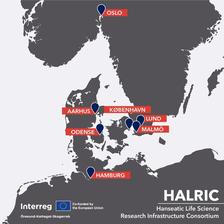Map with the HALRIC project partners
The European Union is providing around eleven million euros to fund the cooperation between German and southern Scandinavian research in the field of life sciences. The research network “HALRIC” (“Hanseatic Life Science Research Infrastructure Consortium”) is to coordinate the use of unique large research facilities, such as MAX IV, DESY’s PETRA III and the European XFEL, as well as other technologies in order to boost research and innovation. Up to 75 pilot collaborations between companies, hospitals and universities, and non-university research infrastructures will be established for this purpose. The consortium is made up of universities, hospitals, research institutions, business clusters and regional governments from Germany, Sweden, Denmark and Norway, including the European Molecular Biology Laboratory, the University of Hamburg, the University Medical Centre Hamburg-Eppendorf (UKE) and DESY.
“In these turbulent times, cross-border cooperation in science and research is of utmost importance and sends a powerful signal,” says Hamburg’s Science Senator Katharina Fegebank. “I’m delighted to be continuing our close transnational cooperation between the Hamburg metropolitan region, the greater Copenhagen area and Skåne. This project will further facilitate innovative research projects between research scientists and industry. It will also continue to drive ahead a strategic forum for innovative ideas and developments in the life sciences, strengthening the scientific ecosystem. Since the various research infrastructures complement each other, this collaboration will help us to position the region as a world leader in the life sciences.”
Helmut Dosch, the Chairman of DESY’s Board of Directors, says, “DESY’s X-ray sources provide unique insights into the molecular engine room of life. The insights gained through them are of great relevance to society, as was demonstrated not least by the Covid pandemic. We are pleased to be further intensifying our cooperation with strong partners in Scandinavia and Germany in the field of health research within the framework of HALRIC. In doing so, we are consolidating the commitment demonstrated during HALOS, the successful predecessor to this project.”
“HALRIC is a joint achievement for the University of Hamburg and for the science metropolis of Hamburg,” as Hauke Heekeren, President of the University of Hamburg, points out. “True to the University’s motto ‘A Flagship University – Cooperating and Innovating for a Sustainable Future’, it will conduct research into issues that are important to society, such as combating diseases, ‘life sciences’ and biosciences. The good cooperation is evident in Science City Bahrenfeld: profile- building, internationalisation and scientific excellence are all being expanded through the clusters of excellence in the natural sciences. This is represented, for example, by Prof. Arwen Pearson, one of the initiators of the international project. The consortium is an important sign of our internationalisation strategy and for continuing to network with our Scandinavian partners in the Baltic region.”
Matthias Wilmanns, who heads the EMBL research unit at DESY, adds that, “The European Molecular Biology Laboratory in Hamburg is very pleased to be participating in this project, because it will strengthen our efforts to integrate the biosciences – which is one of EMBL’s missions. As a pan-European institute for molecular biology, we are in a unique position to do this. In recent years, EMBL Hamburg has already been offering high-quality training in structural biology and biophysical techniques to scientists from Hamburg and south-west Scandinavia. With HALRIC, we can expand this exchange and train more people from our partner institutions.”
Medical technology, biotech and the pharmaceutical industry have traditionally played an important role in Hamburg and Schleswig-Holstein. Around 53,000 people work in these fields, generating over three billion euros annually. Basically, “life science” refers to interdisciplinary, application-oriented natural scientific research, as opposed to fundamental research. For more than 30 years, the European Union has been promoting cross-border cooperation between regions and cities that affect daily life within the framework of its Interreg programmes, such as “HALRIC”. Examples include energy and climate change, the labour market and transport.
HALRIC project partners
In addition to the Science Authorities of the City of Hamburg (BWFGB), the German project partners include DESY, European XFEL, the European Molecular Biology Laboratory EMBL, the University of Hamburg, the University Medical Centre Hamburg-Eppendorf and the Life Science North Cluster. Other partners include Lund University and Malm University in Sweden; the University of Copenhagen, the Technical University of Denmark, Aarhus University, and the University of Southern Denmark in Denmark; and the University of Oslo in Norway.
(from DESY News)







